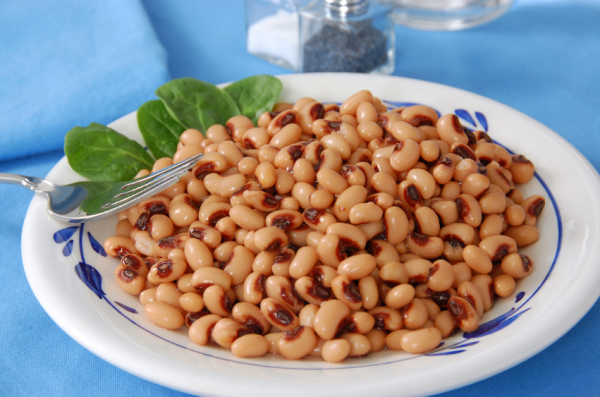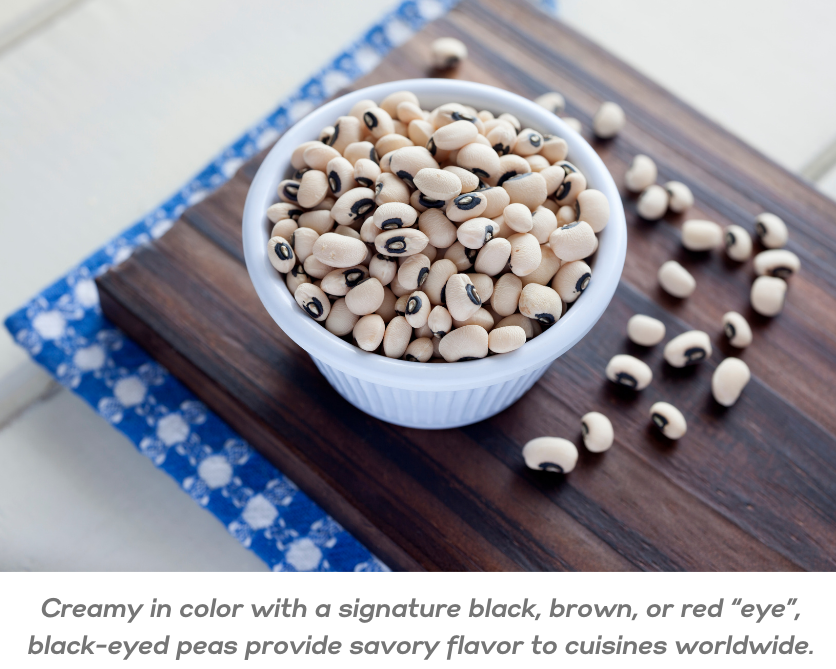Black-Eyed Peas
Creamy in color with a signature black, brown, or red “eye”, black-eyed peas have a long history of providing savory flavor to cuisines across the world. These small but mighty legumes are well-loved for their flavor, nutrients, shelf life, and ease of preparation. If they are not yet a favorite of yours, they may soon become one!
5 QUICK FACTS
Black-eyed peas:
- are actually a type of bean, rather than a pea.
- may also be called “cow peas”, as they are part of the cowpea family.
- originated in West Africa and are grown in warm regions across the world. They have a particularly strong presence in the southern US states of Florida, North and South Carolina, and Texas.
- are traditionally the first food to be eaten on New Year’s Day in many cultures and households for luck and prosperity throughout the year ahead.
- are nutrient-dense, providing protein, fiber, vitamin A, folate, potassium, magnesium, copper, thiamine and iron to support digestive health, weight loss and heart health.
SELECT
Black-eyed peas can be purchased in several forms – fresh (shelled or unshelled), dried, canned, refrigerated (cooked), or frozen (cooked). Farmers markets may offer fresh or dried black-eyed peas, and grocery stores generally have dried and canned, with frozen and refrigerated options becoming more available.
When selecting from loose or packaged dried peas, look for those that are relatively uniform in size, even color, with uncracked hulls. Avoid packages that contain peas that are shriveled or have pinholes.
For canned peas, choose those without dents or bulges.
STORE
Store dried black-eyed peas in an airtight container placed in a cool, dry location off the floor, just as you would other dried beans and legumes. Although dried peas can last up to two years, they will provide the best taste and texture if used within one year.
Canned black-eyed peas should have a “best by” date, which is generally two to three years from the processing date.
Refrigerate cooked black-eyed peas in an airtight container for up to one week or freeze for up to six months.
 Photo: Getty Images
Photo: Getty Images
USE
Before Using Dried Black-Eyed Peas:
As with any dried bean or legume, rinse black-eyed peas thoroughly before cooking and check for stones or debris.
Dried black-eyed peas can be used without soaking but will require additional liquid and a longer cooking time. However, soaking dried beans makes them tender in a shorter amount of time, facilitates even cooking, and also makes them easier for our bodies to digest. I generally use one of the following methods for any variety of dried beans. NOTE: Legumes such as lentils or split peas do not require soaking before use.
- Quick Soak (1 – 4 hours)
Quick soaking is just that, a quicker way to help dried beans become more tender. The longer the soaking time, the less time needed for the bean to cook in the final recipe.
- Place desired amount of beans into a strainer and rinse thoroughly. Pick through to check for stones or other debris to be discarded.
- Transfer the rinsed beans to a large stock pot (with a cover) and cover with about 2 inches of water (approximately 5 cups of water for each 1 cup of dry beans). Heat to boiling, then reduce the heat to a steady simmer and cook for 2 minutes. Remove from heat, cover and soak for 1 – 4 hours.
- Drain and discard the cooking water. Rinse the beans thoroughly before using.
- Traditional Overnight Soak (6 – 12 hours)
This is the most commonly known method – it just requires a bit of forward planning.
- Place desired amount of dried beans into a strainer and rinse thoroughly. Pick through to check for stones or other debris to be discarded.
- Place dried beans in a large pan, bowl or other container, and cover with about 2 inches of water (approximately 5 cups of water for each 1 cup of dried beans). Cover and allow dried beans to soak for 6 – 12 hours.
- Drain and discard the soaking water. Rinse beans thoroughly before using.
Using Canned or Frozen Black-Eyed Peas:
Place the peas into a colander and rinse well with cold water. Canned peas, in particular, may contain a fair amount of salt so rinsing will help remove some of that. Once well drained, add the peas to your desired recipe.
Cooking with Black-Eyed Peas:
Black-eyed peas are a versatile legume and pair well with many types of cuisine. In traditional Southern recipes, black-eyed peas are cooked with meat, spices, and leafy greens. You’ll also commonly find black-eyed peas in Indian curries, such as Lobia or Chawli Curry. I enjoy adding them to many dishes in which I would use other beans – soup, stew, chili, salads, dips – just for a change of pace.
Try using them to make hummus or a white bean dip, adding them to burritos, tacos, rice pilaf, Three Bean or veggie salads, or using them to make veggie burgers. Serve them as an appetizer, entrée, or side dish alongside eggs, grilled or roasted meats or veggies.
RECIPES
Some fun summer ways to enjoy black-eyed peas are –
- Collard Greens with Black-Eyed Peas
- Black-Eyed Pea Salsa (similar to Texas Cowboy Caviar)
Or try something a bit more international…
- Black-Eyed Peas with Coconut Milk and Ethiopian Spices – Marcus Samuelsson / Food & Wine
- Instant Pot Black-Eyed Peas Curry – The Ministry of Curry
- Greek-Style Black-Eyed Peas – The Mediterranean Dish
SHARE
What’s your favorite way to enjoy black-eyed peas? Share it in the comments section.
© 2021 Love + Craft Kitchen, LLC, All Rights Reserved
Main photo: Dried Black-eyed Peas/Canva


Recent Comments